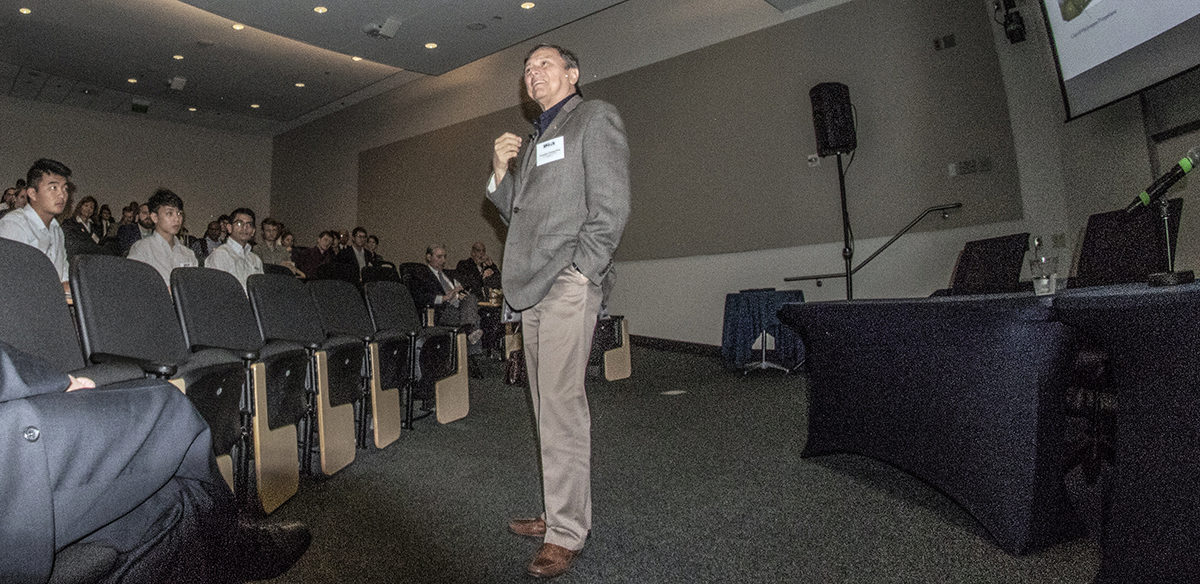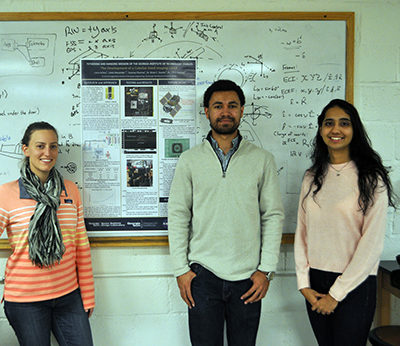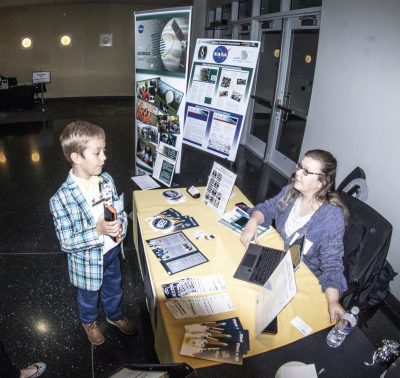 Seven-time Shuttle astronaut Franklin Chang Diaz, Ph.D. addressing attendees at the Second Space Innovations Symposium, held Nov. 13 and 14.
Seven-time Shuttle astronaut Franklin Chang Diaz, Ph.D. addressing attendees at the Second Space Innovations Symposium, held Nov. 13 and 14.
Franklin Chang Diaz challenged listeners to think big when he spoke before the Second Annual Space Innovations Symposium, held Nov. 13 and 14 at Georgia Tech's Global Learning Center.
Recalling the USS Nautlius's historic 1958 journey underneath the North Pole - a feat that demonstrated the submarines' capacity to remain submerged for unprecedented periods of time - Diaz urged attendees to conjure similar resolve and vision when they contemplate their role in the future of space exploration.
"To me, the Nautilus's journey is the paradigm shift that needs to occur now if we are serious about exploring space and becoming a multi-planet species," said the seven-time NASA Shuttle astronaut and inventor of the Variable Specific Impulse Magnetoplasma Rocket (VASIMR) engine.
 |
| The Business of Space. SpaceWorks economic analyst (and Symposium associate chair) Caleb Williams, far left, debated the economics of space with fellow attendees, (L-R): John Olds, Mike Mealing, John Bradford, and Chris Quilty |
"We need a transportation paradigm shift if we want to truly become a space-faring species. Going to Mars and beyond is a whole other game. We need a different view to solve that problem."
Diaz's words enthusiastically received by symposium attendees, who included researchers, academics, entrepreneurs, and policy-makers from the south east and beyond. Some were looking to network, others to invest, still others, to absorb new trends.
Now in its second year, the Symposium on Space Innovations is a public-private partnership between Georgia Tech and members of the Georgia space industry, focused on highlighting recent innovations in the fields of space science and technology.
"This has been a great opportunity for our students to see where their interest in space and space technology can take them," said aerospace engineering professor Dr. E. Glenn Lightsey, the technical chair of the symposium.
 |
| Poster Competition Winners. From left, AE students Lorin Achey, Caleb Alexander, and Saumya Sharma stand next to their poster presentation "TARGIT: The Development of a CubeSat-Sized Imaging LiDAR" which won first place in the Symposium's poster competition. Find out more about their work. |
"And more than just information, they are also witnessing some of the lively discussions and debates that are a part of moving forward. The chatting in the hallways has been almost as interesting as the panel discussions."
Whatever their ultimate goals, all attendees seemed inspired by the same fearless ambition that prompted Diaz to move his then-NASA-based research into the private sector around 10 years ago. At the time, he had to plunk down his life savings - $50,000 - to become the founder and CEO of Ad Astra Rocket Company. It all worked out, though. Earlier this year, he signed a multi-million dollar contract his former employer.
"We are really in an era I'd call 'Space 3.0' where we're seeing a huge number of aerospace start-ups -- may be more than two a month," said Chris Quilty, of Quilty Analytics, a Florida-based investment company.
"And there's venture capital out there to back it up. I'd say it's easily gone from less than $100 million a year 10 years ago, to about $2-3 billion a year now."
Quilty's predictions were confirmed by the wide-ranging array of workshops and panels that were headlined by private investors and start-up companies. In addition to several NASA representatives, there were presenters from Viasat, Xenesis, OneWeb Satellites, Earthly Dynamics, and Ursa Space Systems, to name a few.
 |
| The Future Looks Bright. Eight-year old Hugh Eubanks of Augusta, GA is seen here asking questions of Lori Skillings of the Georgia Space Grant Consortium. Eubanks was, by far, the youngest of the presenters at the Space Symposium Poster Competition. |
Conference chair Judd Ready said the attendance and the energy he observed on the first day of the 2018 event confirmed the planning committee's decision to expand the symposium to two days. A poster session designed to showcase new talent drew submissions from 12 different schools. One of the AE School presenters, Nate Brown, said he made some great connections with student presenters from nearby University of Georgia.
"The students from UGA were excited to hear about our work with Hall Thrusters in small sats [satellites]," he said. "My research is on micro-cracks in Hall Thrusters that are caused by thermal shocks. They did not know that Hall Thrusters could be used in small sats, but they can. They just have more thermal issues. We had a great time talking about it, which would never have happened without the symposium."
As Brown and other students presented their work to swarms of investors, researchers, and entrepreneurs, Ready predicted a strong future for the symposium and the field itself.
"Before sixth grade, every kid you ask will tell you that they are interested in two things: dinosaurs and space," he said. "If we can continue to invest in good STEM educators, we won't lose that enthusiasm - or that talent."
In addition to heavy participation by the space faculty in the Daniel Guggenheim Aerospace Engineering School, the 2018 Symposium received substantial support from GTRI, the Georgia Space Grant Consortium, the Georgia Tech Center for Space Technology And Research (CSTAR), the Georgia Tech Institute for Materials and several private companies, including Viasat, Cobham, Generation Orbit, Blink Astro, Mudd Law, SpaceWorks, Astralytical, Marotta, and Cecil Spaceport.
Daniel Guggenheim School alumnus Admiral James Ellis (ret.) was recently appointed Chairman of the Users Advisory Group to the Vice President's National Space Council. As a keynote speaker at the Symposium, his big picture perspective on the future of the field was riveting. In this video clip, he graciously took a moment to weigh in on one piece of that big picture - space debris and space situational awareness.